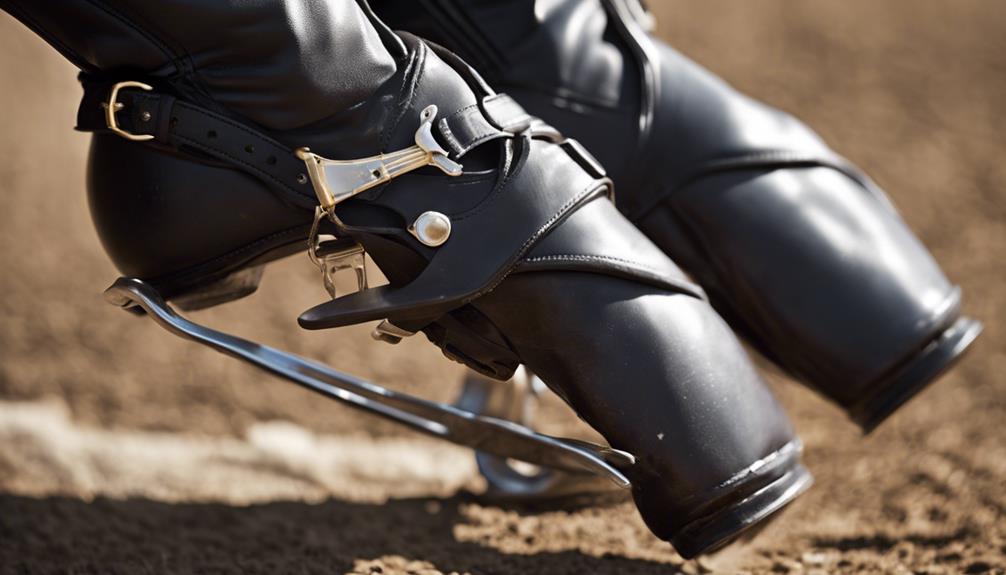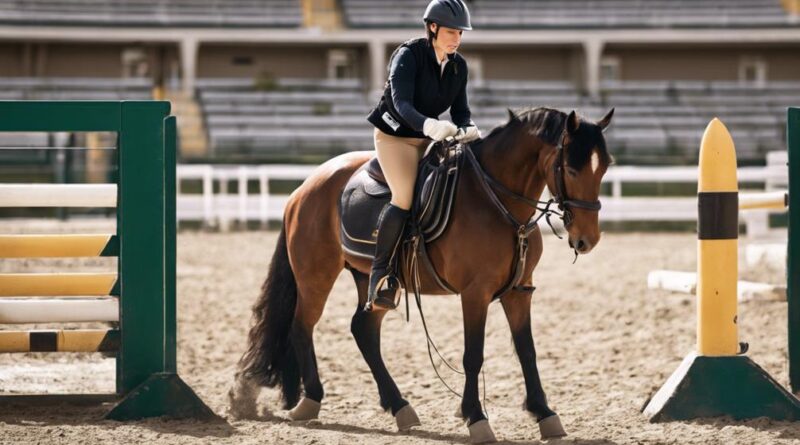Top Measures to Avoid Horse Riding Injuries
Did you know that horse riding accounts for around 50,000 hospital visits each year in the United States alone? Ensuring your safety while enjoying this beloved activity is crucial.
From properly fitting riding gear to understanding horse behavior cues, there are several measures you can take to minimize the risk of injuries.
By implementing these top strategies, you can enhance your riding experience and safeguard yourself from potential harm.
Properly Fitting Riding Gear
To prevent injuries while horse riding, ensure your riding gear fits snugly and comfortably. Properly fitting safety equipment is essential for your protection. Follow these fitting guidelines to ensure your gear provides maximum safety while riding.
When it comes to safety equipment, the helmet is paramount. Make sure your helmet sits level on your head, about two finger-widths above your eyebrows. It should be snug but not tight, with the chinstrap securely fastened. A loose helmet won't protect you in case of a fall. Additionally, check for any cracks or damage to the helmet, as compromised gear can't guarantee your safety.
Next, consider your riding boots. They should fit securely but allow for slight movement of your toes. Your heels should stay down when riding, so ensure the boots have a suitable heel height. Ill-fitting boots can cause discomfort and even lead to accidents due to lack of proper control.
For riding gloves, they should be snug but flexible enough for movement. They should cover your fingers completely and allow you to maintain a good grip on the reins. Properly fitted gloves can prevent blisters and give you better control over your horse.
Regular Horse Riding Lessons
For better horsemanship and enhanced safety, engage in regular horse riding lessons. Learning from experienced instructors can significantly improve your riding techniques and ensure you're equipped with essential safety tips to prevent injuries. Here are five key benefits of participating in regular horse riding lessons:
- Build Confidence: Through consistent lessons, you'll gradually build confidence in handling and riding horses, allowing you to enjoy the experience to the fullest.
- Enhance Skills: Regular lessons will help you develop essential equestrian skills, such as proper posture, balance, and communication with the horse.
- Safety First: Instructors will teach you important safety tips, including how to react in emergencies and how to anticipate and prevent potential accidents.
- Training Drills: Engaging in training drills during lessons won't only improve your riding abilities but also help you understand the importance of practice and consistency.
- Feedback and Corrections: Instructors can provide immediate feedback and corrections during lessons, helping you correct any mistakes and continually progress in your horsemanship journey.
Mindful Horse Selection
Engaging in a mindful selection process when choosing a horse is crucial to ensure a safe and compatible partnership for your riding endeavors. When considering horse temperament, it's essential to find a horse that matches your riding experience and comfort level. Some horses may have a calm and gentle temperament, making them suitable for beginners, while others may be more spirited and energetic, requiring a more experienced rider. Assessing the temperament of a horse before making a selection can significantly impact your riding experience and safety.
Additionally, breed suitability plays a key role in the compatibility between a rider and a horse. Different horse breeds have unique characteristics and tendencies that may align better with certain riding styles or disciplines. For instance, some breeds are known for their strength and suitability for activities like jumping or dressage, while others excel in endurance riding or trail riding. Understanding the traits and tendencies associated with different horse breeds can help you make an informed decision when selecting a horse for your riding pursuits.
Supervised Beginner Training Sessions
Choosing the right horse sets the foundation for safe and enjoyable riding; now, let's explore the importance of supervised beginner training sessions. When starting out in horse riding, supervised training sessions are crucial for your development as a rider. Here's why:
- Expert Guidance: Instructors provide valuable insights into riding techniques and safety protocols, ensuring you learn the right way from the start.
- Build Confidence: Through supervised practice sessions, you gradually gain confidence in handling and riding a horse, making the experience more enjoyable.
- Immediate Feedback: Instructors can correct any mistakes or improper techniques right away, helping you improve faster and prevent bad habits from forming.
- Safety First: With instructor guidance, you learn how to prioritize safety, from mounting the horse to navigating different terrains, reducing the risk of accidents.
- Structured Learning: Supervised sessions offer a structured approach to learning how to ride, progressing at a pace that suits your skill level while focusing on fundamental skills.
Maintaining Proper Riding Posture
To ride safely and effectively, maintaining proper riding posture is essential for both your comfort and control while on horseback. Proper alignment plays a crucial role in ensuring that your body is in the correct position to absorb the movements of the horse. Your head should be up, looking straight ahead, with your shoulders back and down. Keep your back straight but relaxed, engaging your core muscles to support your spine. This alignment helps distribute your weight evenly and allows you to communicate effectively with your horse.
Core strength is fundamental in maintaining proper riding posture. Your core muscles, including your abdominals and lower back, provide stability and balance while riding. By strengthening these muscles, you can improve your posture and prevent slouching, which can lead to discomfort and even injury. Engage your core by imagining pulling your belly button towards your spine while riding. This will help you stay centered and upright in the saddle.
Understanding Horse Behavior Cues
Maintaining proper riding posture not only benefits your comfort and control but also plays a vital role in understanding horse behavior cues while on horseback. By being attuned to your horse's body language and utilizing effective communication techniques, you can establish a harmonious connection with your equine partner.
Here are some key points to help you decipher your horse's cues and enhance your riding experience:
- Watch the Ears: A horse's ears can indicate its mood and level of attentiveness. Forward-pointing ears typically signal engagement, while pinned-back ears may indicate discomfort or aggression.
- Pay Attention to Tail Movements: The position and movement of a horse's tail can convey important information. A relaxed swishing tail indicates contentment, while a tense, elevated tail may signify unease.
- Interpret Body Posture: A horse's overall body posture, including head carriage and leg positioning, can offer insights into its emotional state. A lowered head and relaxed stance often indicate relaxation, while a raised head and stiff stance may suggest alertness or tension.
- Use Vocal Cues: In addition to physical cues, horses respond well to vocal signals. Establishing verbal cues for commands like 'walk,' 'trot,' or 'whoa' can help improve communication between you and your horse.
- Build Trust through Consistency: Consistent handling and clear cues help build trust and rapport with your horse. By maintaining a calm and predictable demeanor, you can foster a strong bond based on mutual understanding and respect.
Using Safety Stirrups

For enhanced safety while horseback riding, consider utilizing safety stirrups to minimize the risk of accidents and injuries. Stirrup safety is a crucial aspect to prevent falls and improve your riding experience. The design of safety stirrups often includes specific features like a wider footbed to provide more stability and prevent your foot from slipping through the stirrup. Additionally, some safety stirrups come with a release mechanism that can open under pressure, allowing your foot to easily come out in case of a fall.
When choosing safety stirrups, pay attention to the stirrup material for both safety and comfort. Look for stirrups made from durable materials like stainless steel or high-quality polymers to ensure their longevity and reliability. Comfort is essential for long rides, so consider safety stirrups with shock-absorbing pads or those designed to reduce strain on your joints.
Investing in safety stirrups is a proactive step towards minimizing the risk of accidents and injuries while horseback riding. Prioritize your safety by selecting stirrups that offer a combination of safety features, thoughtful design, and comfort. By incorporating safety stirrups into your riding gear, you can enjoy your time in the saddle with added peace of mind.
Regular Horse Health Check-Ups
How frequently should you schedule health check-ups for your horse to ensure their well-being and fitness? Regular veterinary exams are crucial for maintaining your horse's health and preventing any potential issues. Here are some essential points to consider:
- Early Detection: Regular check-ups help in early detection of any health concerns, allowing for prompt treatment and preventing further complications.
- Vaccination Updates: Veterinary exams ensure that your horse is up to date on vaccinations, protecting them from various diseases and illnesses.
- Dental Care: Regular check-ups include dental examinations, which are vital for your horse's overall health and well-being.
- Nutritional Guidance: Veterinarians can provide valuable insights into your horse's diet and recommend any necessary adjustments for optimal health.
- Parasite Control: Preventive healthcare measures such as deworming can be discussed during check-ups, ensuring your horse is protected from parasites.
Frequently Asked Questions
How Can I Prevent My Horse From Spooking While Riding?
To prevent your horse from spooking while riding, try using desensitization techniques and consistent training.
Introduce your horse to various stimuli gradually to build confidence and reduce fear reactions. Practice exposing your horse to different environments and objects to help them remain calm during rides.
Are There Any Specific Exercises I Can Do to Improve My Balance While Riding?
To improve your balance while riding, focus on core strengthening with exercises like planks and sit-ups. Incorporate coordination exercises such as leg lifts and arm circles. Flexibility drills like stretching your hamstrings and hips will also help.
Strength training through squats and lunges can enhance your stability on the horse. Consistent practice of these activities will benefit your riding skills and overall balance in the saddle.
What Are Some Common Mistakes Beginners Make While Riding That Can Lead to Injuries?
When starting out, common mistakes can put you at risk of injuries while riding. To prevent this, focus on proper form and technique. Avoid leaning too far forward or back, as it can lead to falls.
Gripping the reins too tightly can cause discomfort and affect control. Stay relaxed and balanced in the saddle to improve your riding experience and reduce the chances of getting hurt.
How Do I Know if My Horse Is in Pain or Discomfort While Riding?
To know if your horse is in pain or discomfort while riding, pay attention to equine behavior and communication cues. Watch for signs like pinned ears, swishing tail, or reluctance to move forward.
Stay tuned to your horse's signals and adjust your riding accordingly. Being aware and responsive to your horse's body language can help prevent potential issues and ensure a safe and enjoyable ride for both of you.
Are There Any Specific Safety Precautions I Should Take When Riding in Different Weather Conditions?
When riding in different weather conditions, make sure you wear proper attire to stay comfortable and safe. Dress in layers for warmth and protection. Use appropriate safety gear like helmets and gloves.
Adjust your riding technique based on the weather to maintain control and balance. Be mindful of slippery surfaces in rain or snow. Stay aware of changing conditions and adjust your riding style accordingly to ensure a safe ride.
Conclusion
To avoid horse riding injuries, make sure your gear fits properly, take regular lessons, choose your horse wisely, and always maintain proper posture.
Stay mindful of horse behavior cues, use safety stirrups, and schedule regular health check-ups for your horse.
By following these measures, you can greatly reduce the risk of accidents and enjoy a safe and enjoyable riding experience.
Ride on!
